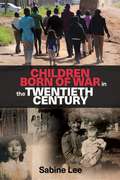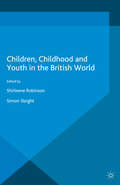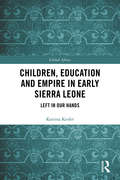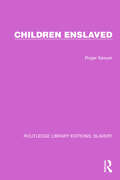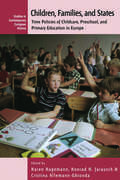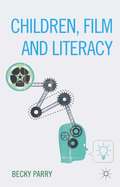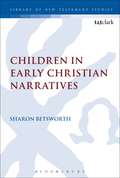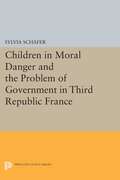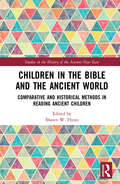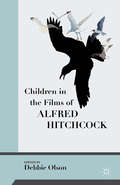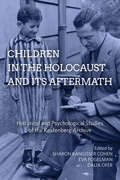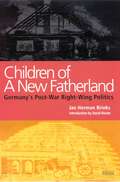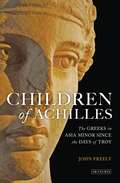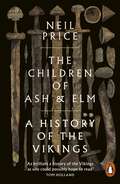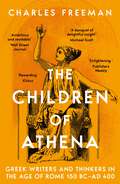- Table View
- List View
Children born of war in the twentieth century
by Sabine LeeThis book explores the life courses of children born of war in different twentieth-century conflicts, including the Second World War, the Vietnam War, the Bosnian War, the Rwandan Genocide and the LRA conflict. It investigates both governmental and military policies vis-à-vis children born of war and their mothers, as well as family and local community attitudes, building a complex picture of the multi-layered challenges faced by many children born of war within their post-conflict receptor communities. Based on extensive archival research, the book also uses oral history and participatory research methods which allow the author to add the voices of the children born of war to historical analysis.
Children, Childhood and Youth in the British World (Palgrave Studies in the History of Childhood)
by Simon Sleight Shirleene RobinsonAge was a critical factor in shaping imperial experience, yet it has not received any sustained scholarly attention. This pioneering interdisciplinary collection is the first to investigate the lives of children and young people and the construction of modes of childhood and youth within the British world.
Children, Education and Empire in Early Sierra Leone: Left in Our Hands (Global Africa)
by Katrina KeeferNineteenth-century Sierra Leone presented a unique situation historically as the focal point of early abolitionist efforts, settlement within West Africa by westernized Africans, and a rapid demographic increase through the judicial emancipation of Liberated Africans. Within this complex and often volatile environment, the voices and experiences of children have been difficult to trace and to follow. Enslaved children historically are a challenging narrative to highlight due to their comparative vulnerability. This book offers newly transcribed data and fills in a lacuna in the scholarship of early Sierra Leone and the Atlantic world. It presents a narrative of children as they experienced a set of circumstances which were unique and important to abolitionist historiography, and demonstrates how each element of that situation arose by analyzing the rich documentary evidence. By presenting the data as well as the individuals whose lives were affected by the mission schools (both as teacher or pupil) this study has sought to be as complete as possible. Underlying the more academic tone is a recognition of the individual humanity of both teachers and students whose lives together shaped this early phase in the history of Sierra Leone. The missionaries who created the documents from which this study arises all died in Sierra Leone after having profound impacts on the lives of many hundreds of pupils. Their students went on to become important historical figures both locally and throughout West Africa. Not all rose to prominence, and the book reconstructs the lives of pupils who became local tradespeople in addition to those who had a greater social stature. This book attempts to offer analysis without forgetting the fundamental human trajectories which this material encompasses.
Children, Education and Empire in Early Sierra Leone: Left in Our Hands (Global Africa)
by Katrina KeeferNineteenth-century Sierra Leone presented a unique situation historically as the focal point of early abolitionist efforts, settlement within West Africa by westernized Africans, and a rapid demographic increase through the judicial emancipation of Liberated Africans. Within this complex and often volatile environment, the voices and experiences of children have been difficult to trace and to follow. Enslaved children historically are a challenging narrative to highlight due to their comparative vulnerability. This book offers newly transcribed data and fills in a lacuna in the scholarship of early Sierra Leone and the Atlantic world. It presents a narrative of children as they experienced a set of circumstances which were unique and important to abolitionist historiography, and demonstrates how each element of that situation arose by analyzing the rich documentary evidence. By presenting the data as well as the individuals whose lives were affected by the mission schools (both as teacher or pupil) this study has sought to be as complete as possible. Underlying the more academic tone is a recognition of the individual humanity of both teachers and students whose lives together shaped this early phase in the history of Sierra Leone. The missionaries who created the documents from which this study arises all died in Sierra Leone after having profound impacts on the lives of many hundreds of pupils. Their students went on to become important historical figures both locally and throughout West Africa. Not all rose to prominence, and the book reconstructs the lives of pupils who became local tradespeople in addition to those who had a greater social stature. This book attempts to offer analysis without forgetting the fundamental human trajectories which this material encompasses.
Children Enslaved (Routledge Library Editions: Slavery #5)
by Roger SawyerChildren Enslaved, first published in 1988, reveals the full extent of child slavery throughout the world. By personal investigation in regions where slavery still prevails, and with extensive research into documentation provided by international organizations defending children’s rights, the author gives the most comprehensive assessment available of contemporary child slavery. He describes both persisting traditional forms of child exploitation and modern abuses and deprivations of freedom, including child migrant workers and those involved in the manufacturing industry, and the desolate world of child pornography and sexual exploitation.
Children Enslaved (Routledge Library Editions: Slavery #5)
by Roger SawyerChildren Enslaved, first published in 1988, reveals the full extent of child slavery throughout the world. By personal investigation in regions where slavery still prevails, and with extensive research into documentation provided by international organizations defending children’s rights, the author gives the most comprehensive assessment available of contemporary child slavery. He describes both persisting traditional forms of child exploitation and modern abuses and deprivations of freedom, including child migrant workers and those involved in the manufacturing industry, and the desolate world of child pornography and sexual exploitation.
Children, Families, and States: Time Policies of Childcare, Preschool, and Primary Education in Europe (Contemporary European History #8)
by Karen Hagemann, Konrad H. Jarausch, Cristina Allemann-GhiondaDue to the demand for flexible working hours and employees who are available around the clock, the time patterns of childcare and schooling have increasingly become a political issue. Comparing the development of different “time policies” of half-day and all-day provisions in a variety of Eastern and Western European countries since the end of World War II, this innovative volume brings together internationally known experts from the fields of comparative education, history, and the social and political sciences, and makes a significant contribution to this new interdisciplinary field of comparative study.
Children, Film and Literacy
by Becky ParryChildren, Film and Literacy explores the role of film in children's lives. The films children engage in provide them with imaginative spaces in which they create, play and perform familiar and unfamiliar, fantasy and everyday narratives and this narrative play is closely connected to identity, literacy and textual practices. Family is key to the encouragement of this social play and, at school, the playground is also an important site for this activity. However, in the literacy classroom, some children encounter a discontinuity between their experiences of narrative at home and those that are valued in school. Through film children develop understandings of the common characteristics of narrative and the particular 'language' of film. This book demonstrates the ways in which children are able to express and develop distinct and complex understandings of narrative, that is to say, where they can draw on their own experiences (including those in a moving image form). Children whose primary experiences of narrative are moving images face particular challenges when their experiences are not given opportunities for expression in the classroom, and this has urgent implications for the teaching of literacy.
Children in Early Christian Narratives (The Library of New Testament Studies #521)
by Sharon BetsworthSharon Betsworth examines the narratives, parables, and teachings of and about children in the gospels and the literature of Early Christianity. Betsworth begins with a discussion of the social-historical context of children and childhood in the first century before discussing the role of children in all four gospels. She shows that for Mark and Matthew, children are integral to understanding each evangelist's perspective on the reign of God and on Jesus' identity in each Gospel. In the Gospel of Luke the childhood of Jesus is shown to be crucial to the broader themes of the Gospel. In the Gospel of John, Betsworth examines the metaphorical use of the word 'children' looking at 'children of light' and of 'darkness'. She then explores stories of Jesus' childhood in the non-canonical Infancy Gospels of James and Thomas, as well as the childhood of his mother, Mary in the latter shedding light upon views of children, discipleship, and the person of Jesus in early christianity and in the ancient world more generally.
Children in Early Christian Narratives (The Library of New Testament Studies #521)
by Sharon BetsworthSharon Betsworth examines the narratives, parables, and teachings of and about children in the gospels and the literature of Early Christianity. Betsworth begins with a discussion of the social-historical context of children and childhood in the first century before discussing the role of children in all four gospels. She shows that for Mark and Matthew, children are integral to understanding each evangelist's perspective on the reign of God and on Jesus' identity in each Gospel. In the Gospel of Luke the childhood of Jesus is shown to be crucial to the broader themes of the Gospel. In the Gospel of John, Betsworth examines the metaphorical use of the word 'children' looking at 'children of light' and of 'darkness'. She then explores stories of Jesus' childhood in the non-canonical Infancy Gospels of James and Thomas, as well as the childhood of his mother, Mary in the latter shedding light upon views of children, discipleship, and the person of Jesus in early christianity and in the ancient world more generally.
Children in Moral Danger and the Problem of Government in Third Republic France (PDF)
by Sylvia SchaferBy exploring how children and their families became unprecedented objects of governmental policy in the early decades of France's Third Republic, Sylvia Schafer offers a fresh perspective on the self-fashioning of a new governmental order. In the aftermath of the Franco-Prussian War, social reformers claimed that children were increasingly the victims of their parents' immorality. Schafer examines how government officials codified these claims in the period between 1871 and 1914 and made the moral status of the family the focus of new kinds of legislative, juridical, and administrative action. Although the debate on moral danger in the family helped to articulate the young republic's claim to moral authority in the metaphors of parenthood, the definition of "moral endangerment" remained ambiguous. Schafer shows how public authorities reshaped their agenda and varied their remedies as their schemes for protecting morally endangered children broke down under the enduring weight of this ambiguity.Drawing on insights from feminist theory, literary studies, and the work of Michel Foucault, Schafer reveals the cultural complexity of civil justice and social administration in both their formal and everyday incarnations. In demonstrating the centrality of ambivalence as a condition of liberal government and governmental representations, she fundamentally recasts the history of the early Third Republic and, more widely, issues a powerful challenge to conventional views of the modern state and its history.Originally published in 1997.The Princeton Legacy Library uses the latest print-on-demand technology to again make available previously out-of-print books from the distinguished backlist of Princeton University Press. These editions preserve the original texts of these important books while presenting them in durable paperback and hardcover editions. The goal of the Princeton Legacy Library is to vastly increase access to the rich scholarly heritage found in the thousands of books published by Princeton University Press since its founding in 1905.
Children in the Bible and the Ancient World: Comparative and Historical Methods in Reading Ancient Children (Studies in the History of the Ancient Near East)
by Shawn W. FlynnThe topic of children in the Bible has long been under-represented, but this has recently changed with the development of childhood studies in broader fields, and the work of several dedicated scholars. While many reading methods are employed in this emerging field, comparative work with children in the ancient world has been an important tool to understand the function of children in biblical texts. Children in the Bible and the Ancient World broadly introduces children in the ancient world, and specifically children in the Bible. It brings together an international group of experts who help readers understand how children are constructed in biblical literature across three broad areas: children in the Hebrew Bible and the Ancient Near East, children in Christian writings and the Greco-Roman world, and children and materiality. The diverse essays cover topics such as: vows in Ugarit and the Hebrew Bible, obstetric knowledge, infant abandonment, the role of marriage, Greek abandonment texts, ritual entry for children into Christian communities, education, sexual abuse, and the role of archeological figurines in children’s lives. The volume also includes expertise in biological anthropology to study the skeletal remains of ancient children, as well as how ancient texts illuminate Mary’s female maturity. The volume is written in an accessible style suitable for non-specialists, and it is equipped with a helpful resource bibliography that organizes select secondary sources from these essays into meaningful categories for further study. Children in the Bible and the Ancient World is a helpful introduction to any who study children and childhood in the ancient world. In addition, the volume will be of interest to experts who are engaged in historical approaches to biblical studies, while appreciating how the ancient world continues to illuminate select topics in biblical texts.
Children in the Bible and the Ancient World: Comparative and Historical Methods in Reading Ancient Children (Studies in the History of the Ancient Near East)
by Shawn W. FlynnThe topic of children in the Bible has long been under-represented, but this has recently changed with the development of childhood studies in broader fields, and the work of several dedicated scholars. While many reading methods are employed in this emerging field, comparative work with children in the ancient world has been an important tool to understand the function of children in biblical texts. Children in the Bible and the Ancient World broadly introduces children in the ancient world, and specifically children in the Bible. It brings together an international group of experts who help readers understand how children are constructed in biblical literature across three broad areas: children in the Hebrew Bible and the Ancient Near East, children in Christian writings and the Greco-Roman world, and children and materiality. The diverse essays cover topics such as: vows in Ugarit and the Hebrew Bible, obstetric knowledge, infant abandonment, the role of marriage, Greek abandonment texts, ritual entry for children into Christian communities, education, sexual abuse, and the role of archeological figurines in children’s lives. The volume also includes expertise in biological anthropology to study the skeletal remains of ancient children, as well as how ancient texts illuminate Mary’s female maturity. The volume is written in an accessible style suitable for non-specialists, and it is equipped with a helpful resource bibliography that organizes select secondary sources from these essays into meaningful categories for further study. Children in the Bible and the Ancient World is a helpful introduction to any who study children and childhood in the ancient world. In addition, the volume will be of interest to experts who are engaged in historical approaches to biblical studies, while appreciating how the ancient world continues to illuminate select topics in biblical texts.
Children in the Films of Alfred Hitchcock
by Debbie OlsonChildren and youth perform both innocence and knowingness within Hitchcock's complex cinematic texts. Though the child often plays a small part, their significance - symbolically, theoretically, and philosophically - offers a unique opportunity to illuminate and interrogate the child presence within the cinematic complexity of Hitchcock's films.
Children in the Holocaust and its Aftermath: Historical and Psychological Studies of the Kestenberg Archive
by Sharon Kangisser Cohen, Eva Fogelman Dalia OferThe testimonies of individuals who survived the Holocaust as children pose distinct emotional and intellectual challenges for researchers: as now-adult interviewees recall profound childhood experiences of suffering and persecution, they also invoke their own historical awareness and memories of their postwar lives, requiring readers to follow simultaneous, disparate narratives. This interdisciplinary volume brings together historians, psychologists, and other scholars to explore child survivors’ accounts. With a central focus on the Kestenberg Holocaust Child Survivor Archive’s over 1,500 testimonies, it not only enlarges our understanding of the Holocaust empirically but illuminates the methodological, theoretical, and institutional dimensions of this unique form of historical record.
Children, Media, and American History: Printed Poison, Pernicious Stuff, and Other Terrible Temptations
by Margaret CassidyPrinted poison. Pernicious stuff. Since the nineteenth century, these are some of the many concerned comments critics have made about media for children. From dime novels to comic books to digital media, Cassidy illustrates the ways children have used "old media" when they were first introduced as "new media." Further, she interrogates the extent to which different conceptions of childhood have influenced adults’ reactions to children’s use of media. Exploring the history of American children and media, this text presents a portrait of the way in which children and adults adapt to a constantly changing media environment.
Children, Media, and American History: Printed Poison, Pernicious Stuff, and Other Terrible Temptations
by Margaret CassidyPrinted poison. Pernicious stuff. Since the nineteenth century, these are some of the many concerned comments critics have made about media for children. From dime novels to comic books to digital media, Cassidy illustrates the ways children have used "old media" when they were first introduced as "new media." Further, she interrogates the extent to which different conceptions of childhood have influenced adults’ reactions to children’s use of media. Exploring the history of American children and media, this text presents a portrait of the way in which children and adults adapt to a constantly changing media environment.
Children of a New Fatherland: Germany's Post-war Right Wing Politics
by Jan Herman BrinksThis is a powerful study of the growth of the right wing in a reunited Germany. Setting this in its historical context, and especially in the context of the end of the Cold War, the author examines the implosion of communism and of the growth of xenophobia and right-wing politics in modern and contemporary Europe. The backdrop of 20th century German history and of Germany's position as the European regional super-power make this book an especially important and topical contribution.
The Children of Abraham: Judaism, Christianity, Islam (Princeton Classics #34)
by F. E. PetersF.E. Peters, a scholar without peer in the comparative study of Judaism, Christianity, and Islam, revisits his pioneering work. Peters has rethought and thoroughly rewritten his classic The Children of Abraham for a new generation of readers-at a time when the understanding of these three religious traditions has taken on a new and critical urgency. He began writing about all three faiths in the 1970s, long before it was fashionable to treat Islam in the context of Judaism and Christianity, or to align all three for a family portrait. In this updated edition, he lays out the similarities and differences of the three religious siblings with great clarity and succinctness and with that same remarkable objectivity that is the hallmark of all the author's work. Peters traces the three faiths from the sixth century B.C., when the Jews returned to Palestine from exile in Babylonia, to the time in the Middle Ages when they approached their present form. He points out that all three faith groups, whom the Muslims themselves refer to as "People of the Book," share much common ground. Most notably, each embraces the practice of worshipping a God who intervenes in history on behalf of His people. The book's text is direct and accessible with thorough and nuanced discussions of each of the three religions. Footnotes provide the reader with expert guidance into the highly complex issues that lie between every line of this stunning edition of The Children of Abraham. Complete with a new preface by the author, this Princeton Classics edition presents this landmark study to a new generation of readers.
The Children of Abraham: Judaism, Christianity, Islam (Princeton Classics)
by F. E. PetersF.E. Peters, a scholar without peer in the comparative study of Judaism, Christianity, and Islam, revisits his pioneering work. Peters has rethought and thoroughly rewritten his classic The Children of Abraham for a new generation of readers-at a time when the understanding of these three religious traditions has taken on a new and critical urgency. He began writing about all three faiths in the 1970s, long before it was fashionable to treat Islam in the context of Judaism and Christianity, or to align all three for a family portrait. In this updated edition, he lays out the similarities and differences of the three religious siblings with great clarity and succinctness and with that same remarkable objectivity that is the hallmark of all the author's work. Peters traces the three faiths from the sixth century B.C., when the Jews returned to Palestine from exile in Babylonia, to the time in the Middle Ages when they approached their present form. He points out that all three faith groups, whom the Muslims themselves refer to as "People of the Book," share much common ground. Most notably, each embraces the practice of worshipping a God who intervenes in history on behalf of His people. The book's text is direct and accessible with thorough and nuanced discussions of each of the three religions. Footnotes provide the reader with expert guidance into the highly complex issues that lie between every line of this stunning edition of The Children of Abraham. Complete with a new preface by the author, this Princeton Classics edition presents this landmark study to a new generation of readers.
The Children of Abraham: Judaism, Christianity, Islam
by F. E. Peters John L. EspositoF.E. Peters, a scholar without peer in the comparative study of Judaism, Christianity, and Islam, revisits his pioneering work after twenty-five years. Peters has rethought and thoroughly rewritten his classic The Children of Abraham for a new generation of readers-at a time when the understanding of these three religious traditions has taken on a new and critical urgency. He began writing about all three faiths in the 1970s, long before it was fashionable to treat Islam in the context of Judaism and Christianity, or to align all three for a family portrait. In this updated edition, he lays out the similarities and differences of the three religious siblings with great clarity and succinctness and with that same remarkable objectivity that is the hallmark of all the author's work. Peters traces the three faiths from the sixth century B.C., when the Jews returned to Palestine from exile in Babylonia, to the time in the Middle Ages when they approached their present form. He points out that all three faith groups, whom the Muslims themselves refer to as "People of the Book," share much common ground. Most notably, each embraces the practice of worshipping a God who intervenes in history on behalf of His people. The book's text is direct and accessible with thorough and nuanced discussions of each of the three religions. Updated footnotes provide the reader with expert guidance into the highly complex issues that lie between every line of this stunning and timely new edition of The Children of Abraham. ?
The Children of Abraham: Judaism, Christianity, Islam
by F. E. Peters John L. EspositoF.E. Peters, a scholar without peer in the comparative study of Judaism, Christianity, and Islam, revisits his pioneering work after twenty-five years. Peters has rethought and thoroughly rewritten his classic The Children of Abraham for a new generation of readers-at a time when the understanding of these three religious traditions has taken on a new and critical urgency. He began writing about all three faiths in the 1970s, long before it was fashionable to treat Islam in the context of Judaism and Christianity, or to align all three for a family portrait. In this updated edition, he lays out the similarities and differences of the three religious siblings with great clarity and succinctness and with that same remarkable objectivity that is the hallmark of all the author's work. Peters traces the three faiths from the sixth century B.C., when the Jews returned to Palestine from exile in Babylonia, to the time in the Middle Ages when they approached their present form. He points out that all three faith groups, whom the Muslims themselves refer to as "People of the Book," share much common ground. Most notably, each embraces the practice of worshipping a God who intervenes in history on behalf of His people. The book's text is direct and accessible with thorough and nuanced discussions of each of the three religions. Updated footnotes provide the reader with expert guidance into the highly complex issues that lie between every line of this stunning and timely new edition of The Children of Abraham. ?
Children of Achilles: The Greeks in Asia Minor since the Days of Troy
by John FreelySince the days of Troy historic lands of Asia Minor have been home to Greeks. They are steeped in a rich fusion of Greek and Turkish culture and the histories of both are irrevocably entwined, fatefully connected. Children of Achilles tells the epic and ultimately tragic story of the Greek presence in Anatolia, beginning with the Trojan War and culminating in 1923 with the devastating population exchange that followed the Turkish War of Independence. The once magnificent, now ruined, cities that cluster along the Aegean and Mediterranean coasts of Turkey are reminders of a civilization that produced the first Hellenic enlightenment, giving birth to Homer, Herodotus and the first philosophers of nature. For more three millennia the Anatolian Greeks preserved their identity and culture as the tides of history washed over them, enduring conflicts that historians since Herodotus have seen as an unending clash of civilizations between East and West. Today, the memory of the Greek diaspora from Asia Minor lives on in the music of rebetika, the threnodies known as amanadas, and the poetry of Seferis, and even now the descendants of those exiles speak with nostalgia of 'i kath'imas Anatoli' - our own Anatolia, their lost homeland. This, told for the first time, is their story, from glorious beginnings to a bitter end, a story that continues to echo through the ages and across continents.
The Children of Ash and Elm: A History of the Vikings
by Neil Price'As brilliant a history of the Vikings as one could possibly hope to read' Tom Holland The 'Viking Age' is traditionally held to begin in June 793 when Scandinavian raiders attacked the monastery of Lindisfarne in Northumbria, and to end in September 1066, when King Harald Hardrada of Norway died leading the charge against the English line at the Battle of Stamford Bridge. This book, the most wide-ranging and comprehensive assessment of the current state of our knowledge, takes a refreshingly different view. It shows that the Viking expansion began generations before the Lindisfarne raid, and traces Scandinavian history back centuries further to see how these people came to be who they were.The narrative ranges across the whole of the Viking diaspora, from Vinland on the eastern American seaboard to Constantinople and Uzbekistan, with contacts as far away as China. Based on the latest archaeology, it explores the complex origins of the Viking phenomenon and traces the seismic shifts in Scandinavian society that resulted from an economy geared to maritime war. Some of its most striking discoveries include the central role of slavery in Viking life and trade, and the previously unsuspected pirate communities and family migrations that were part of the Viking 'armies' - not least in England.Especially, Neil Price takes us inside the Norse mind and spirit-world, and across their borders of identity and gender, to reveal startlingly different Vikings to the barbarian marauders of stereotype. He cuts through centuries of received wisdom to try to see the Vikings as they saw themselves - descendants of the first human couple, the Children of Ash and Elm. Healso reminds us of the simultaneous familiarity and strangeness of the past, of how much we cannot know, alongside the discoveries that change the landscape of our understanding. This is an eye-opening and surprisingly moving book.
The Children of Athena: Greek writers and thinkers in the Age of Rome, 150 BC–AD 400
by Charles FreemanThe remarkable story of how Greek-speaking writers and thinkers sustained and developed the intellectual legacy of Classical Greece under the rule of Rome.In 146 BC, Greece yielded to the military might of the Roman Republic; some sixty years later, when Athens and other Greek city-states rebelled against Rome, the general Lucius Cornelius Sulla destroyed the city of Socratesand Plato, laying waste the famous Academy where Aristotle had studied.However, the traditions of Greek cultural life would continue to flourish – across the eastern Mediterranean world and beyond – during the centuries of Roman rule that followed, in the lives and work of a distinguished array of philosophers, rhetoricians, historians, doctors, scientists, geographers and theologians.Charles Freeman's accounts of such luminaries as the polymathic physician Galen, the soldier-botanist Dioscorides, the Alexandrian geographer and astronomer Ptolemy and the Neoplatonic philosopher Plotinus are interwoven with 'interludes' that counterpoint and contextualise a sequence of unjustly neglected and richly influential lives.This is the story of a vibrant, constantly evolving tradition of intellectual inquiry across a period of more than five hundred years, from the second century BC to the start of the fifth century ad – one that would help shape the intellectual landscape of the Middle Ages and long after. The Children of Athena is a cultural history on an epic scale.
